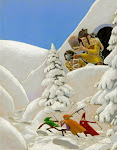While as power creep expanded out of control in the the Forgotten Realms, the NPC's in the original grey boxed set are actually not that powerful by AD&D standards.
I took down the class and level of all the NPC's listed in the grey boxed set and this is what I came up with:
Summary of Notable NPC's (70 total listed) from the Realms:
Class Level
Bard : 2 Min. : 1.0
Cleric : 9 1st Qu.: 6.0
Druid : 3 Median : 7.5
Fighter:16 Mean : 8.8
Ranger : 6 3rd Qu.:11.0
Thief : 4 Max. :27.0
Wizard :30
The average NPC is around 8-9 level, the notable NPC list is dominated by Wizards and Fighters! I lumped paladins in with clerics, so that list is inflated some due to that fact. Visually you can see how the list is broken out here:
Looking at the overall distribution of Notable NPC levels:
Most of the notable NPC's are between 4-11th level. This would mean that the majority of folks living in the realms are probably commen "men" or at most 1-2 level fighters. The people in this list are stand outs.
In my game I'm not really planning on using any specific NPC's from the books, just as inspiration and guidance for my own version of the realms. For my current game employing Swords and Wizardry Whitebox I'm going to scale the average NPC level back even further, probably dropping the average level for "Notable" NPC's to around 5th level and removing all the 20+ characters.
Here are the same NPC statistics broken out by class:
One of the things I noticed from this list, is that high level clerics are rare. This means in order to find somebody to raise dead, you are going to have to travel, and then probably prove your worthiness by gold or deed to obtain the spell (at least until the party cleric can cast the spell). I also think there should be some kind of permanent penalty for dying so I will probably make each raise dead lower your constitution score by 1 and maybe make the player roll under their Con on a d20 to actually be raised. That will limit the number of raise dead attempts in any game. I don't want death to have absolutely no bite.
[New Spell] Cannot Be Silent
-
Cannot Be Silent ‘WHY ARE WE SHOUTING?’ Wrilk the dwarf asked. ‘I DON’T
KNOW, I AM TRYING NOT TO,’ Bakrado replied. ‘I AM SURE THAT SNICKERING
IDIOT SPELLC...
9 hours ago







